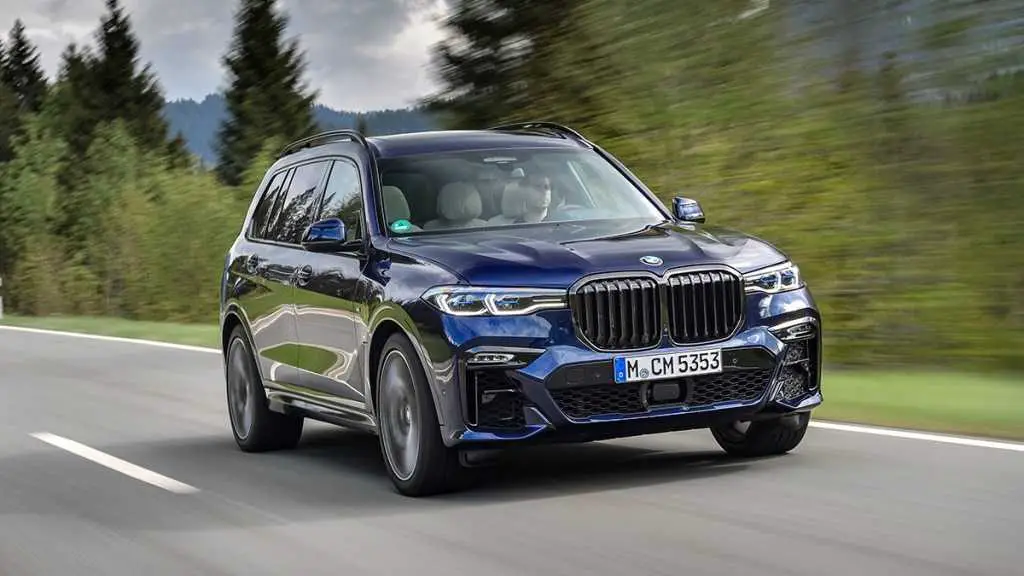BMW X5 PLUG-IN HYBRID 2023 Refueling System
The BMW X5 Plug-In Hybrid 2023 is a big step forward in the world of luxury SUVs. It combines cutting-edge technology with engineering that is good for the environment. This amazing car has a plug-in hybrid engine, which makes it efficient and good for the environment. It also has the dynamic performance and high-quality craftsmanship that BMW is known for. As the car industry continues to move toward greener solutions, the X5 Plug-In Hybrid stands out as a strong contender. It can be driven only on electricity and can also be refueled with gasoline, giving it a lot of options. In this in-depth look, we’ll go over the most important parts of refueling this great hybrid SUV. We’ll talk about everything from charging at home to using public charging infrastructure and making sure that your driving experience is not only efficient but also incredibly easy.
2023 BMW X5 Specs, Price, Features, Mileage (Brochure)
Charging the vehicle
Vehicle features and options
This chapter describes all standard, country-specific and optional features offered by the series. It also describes features and functions that are not necessarily available in your vehi-cle, e.g., due to the selected options or country versions. This also applies to safety-related functions and systems. When using these functions and systems, the applicable laws and regulations must be observed.
General information
The vehicle can be charged using various charging cables at charging stations or domes-tic socket outlets.
Control and monitoring of the charging process are handled fully automatically. When charging with AC, the charge current level can be adjusted via iDrive.
Safety information
Warning
Working with electrical current improperly can lead to electric shock due to high voltages or high currents. There is a risk of fire or danger to life. Observe the general safety regulations when working with electrical current.
Warning
A faulty or incorrectly designed charging device at the charging location can cause damage to the vehicle and overload the power supply at the charging location. There is a risk of fire and an injury hazard. The manufacturer of your vehicle recommends that, prior to your first use of a charging location, you have the compatibility of the following components confirmed:
- Charging cable.
- Charging station.
- Domestic socket outlet and connected circuits.
Warning
Damaged or worn chargers, for instance, worn contacts, can heat up. There is a risk of fire. Only use chargers that are in good condition.
Warning
Simultaneous charging and refueling pose a risk of fire if a sufficient safety distance from easily flammable materials is not maintained. There is a risk of injury or risk of damage to property. Do not refuel and charge the vehicle at the same time.
Warning
Contact with live components can lead to an electric shock. High voltage is present at the charging connection. There is a risk of injury or danger to life.
The manufacturer of your vehicle recommends that work on the charging connection, for instance, cleaning, be performed by an authorized service center or another qualified service center or repair shop.
NOTICE
The charging cable connected to the vehicle and the charging cable connections may be damaged due to mechanical load. There is a risk of damage to property, among other potential damage. Do not apply mechanical loads to the charging cable and the charging cable connections. Route the charging cable to the vehicle freely and avoid stress due to pulling or bending.
Charging from the power grid
The high-voltage battery is used as an energy accumulator. The high-voltage battery can be charged utilizing energy recovery during the trip or via the power grid.
Charge the vehicle at a suitable charging device.
Charge the high-voltage battery regularly so that it operates optimally.
When charging via the power grid, you can choose between the following variants:
- Domestic socket outlet.
- AC charging station.
For optimal use of the energy from the power grid, charging at a charging station, e.g., at a BMW Wallbox, is recommended.
Ensure that the charging station is installed according to the technical requirements of the power grid, e.g. by a qualified electrician.
Charge current
General information
The charge current strength is indicated in amperes. There are differences in the maximum permissible charging current depending on the local power grid.
Before charging, set a suitable current limit for the charging current.
When charging at charging stations, the permissible charging current is automatically detected and a current limit is set.
When charging at a domestic socket outlet, set the current limit yourself.
Charging on a domestic socket
outlet
The permitted charge current strength must be determined, for instance by a qualified electrician, before first charging with your own domestic socket outlet or when charging with third-party domestic socket outlets.
The current limit of the charge current strength can be set via iDrive.
Current limit
General information
The current limit for charging via the Mode 2 charging cable can be set.
Depending on the electrical mains, the vehicle must be charged with a different charge current strength.
Setting the current limit
- CAR”
- Plan charge/climate”
- Tilt the Controller to the right.
- Settings”
- AC settings”
- Current limit”
- Select the desired setting.
Settings are stored. When you change charging locations you also might need to change the setting for charging. Set the charge current strength at third-party domestic socket outlets to the lowest level.
Maintaining the charge state
If it is necessary to conserve the electrical range for a later time during the trip, for example, BATTERY CONTROL can be used to maintain or increase the current charge state of the high-voltage battery.
Charging cable
General information
Use a Mode 2 charging cable, a Mode 3 charging cable, or the permanently installed charging cable of a charging station to charge the vehi-cle.
Different charging cables can be required depending on the country.
Safety information
Warning
Non-compatible charging cables or unsuitable charging stations can heat up and cause damage to the vehicle. There is a risk of fire. Use charging cables or charging stations for charging that are suitable for the respective vehicle type.
An authorized service center will be glad to provide information about suitable charging cables.
Warning
Improper use of the charging cable can prevent charging and lead to damage, for instance cable fire. There is a risk of fire. Use the charging cable only for charging the vehicle, and do not extend it using cables or adapters.
Warning
Damaged charging cables can heat up or lead to an electric shock. There is a risk of fire or an injury hazard. Use undamaged charging cables only.
Mode 2 charging cable
Depending on the national market version, the vehicle scope of delivery includes a Mode 2 charging cable.
Mode 2 charging cables can be used to charge the vehicle from grounded domestic socket outlets. Charging at domestic socket outlet electrical connections is performed with alternating current.
When a Mode 2 charging cable is used, the efficiency values may differ from those stated on the energy label.
The Mode 2 charging cable is also referred to as a standard charging cable.
Mode 3 charging cable
Depending on the national market version, the vehicle scope of delivery includes a Mode 3 charging cable.
The Mode 3 charging cable makes it possible to quickly recharge at sockets of designated AC charging stations using a special connector. Charging is performed with alternating current at designated AC charging stations. The charging process can be completed faster than at domestic socket outlets.
A charge current level up max. 16 A is possible.
The charging cable may be permanently installed at the charging station.
The Mode 3 charging cable is also referred to as AC quick charging cable.
Storage
For the delivery, the charging cable is stowed in the luggage compartment, for instance, under the cargo floor panel or in a bag.
Stow the charging cable after use in the same place again.
If the charging cable is stowed in a bag, fasten the bag at an open lashing eye in the luggage compartment.
If required, store the charging cable with the installed connector cover to prevent moisture in the charging cable plug.
Connecting
General information
Before connecting, if necessary clean the charging cable plug and the area between the charging socket cover and charging socket, e.g., remove snow.
Charging socket cover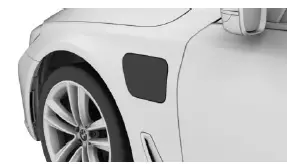
The charging socket cover is located in front on the left side of the vehicle.
Always keep the charging socket clean and unobstructed.
Keep the charging socket cover closed when the charging socket is not used.
Connecting a charging cable
To connect, engage the selector lever position P, deactivate the drive-ready state and unlock the vehicle. Set the parking brake, if needed.
- To open the charging socket cover, press on the rear edge, arrow. The charging socket cover opens.
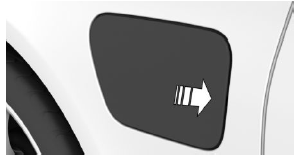
- Connect the Mode 2 charging cable to the domestic socket outlet or the Mode 3 charging cable to the port at the AC charging station.
- Insert the appropriate charging cable connection, and push it in until it engages.
- Hold the charging cable until it is correctly locked.
2023 BMW X5 Specs, Price, Features, Mileage (Brochure)
Removing
General information
When the vehicle is locked, the charging cable is locked. Unlock the vehicle before removing the cable.
If necessary, clean the area between the charging socket cover and charging socket, for instance from snow, before removing it.
Disconnecting a charging cable
- Unlock the vehicle with the vehicle key if it is locked. The charging cable is unlocked.
- Press the release button on the handle, arrow 1, and grasp the charging cable at the gripping areas.
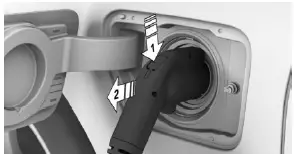
- Detach the charging cable from the charging socket, arrow 2.
- Press on the charging socket cover until it engages.
- Attach cover of the charging cable connector, if needed.
- Remove the mode 2 charging cable from the domestic socket outlet or the fast charging cable (mode 3) from the socket on the AC charging station as needed.
- Stow the charging cable.
At a charging station, insert the permanently installed charging cable in the place provided for it.
Performing emergency release
The charging cable is locked when the vehicle is locked and during the charging process.
In case of an electrical malfunction, the charging cable can be manually unlocked.
- Opening the hood.
- Release the button from the holder.
 Pull the knob.
Pull the knob.
The charging cable is manually unlocked.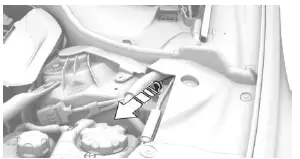
- The charging cable is manually unlocked.
Detach
Have the locking system of the charging socket checked at the authorized service center or an-other qualified service center or repair shop after the emergency unlocking of the charging cable.
Charging process
General information
At high or low outside temperatures, preheat-ing/precooling the high-voltage battery may lead to longer charging times.
If the Mode 2 charging cable is exposed to high temperatures and direct sunlight, this may interrupt the charging process. Charging will resume automatically.
A charging procedure is canceled or not started due to the installation of a Remote Software Upgrade. The charging procedure may not continue automatically after the successful installation.
Safety information
Warning
Improper use of the power mains connection can lead to damage, for instance cable fire. There is a risk of injury or risk of damage to property. Use the charging cable only for charging the vehicle, and do not extend it using cables or adapters.
Warning
If the charge current strength is adjusted incorrectly, the power grid of the domestic socket outlet can be overloaded and over-heat. There is a risk of fire. Adjust the charge current strength to the power grid prior to charging on domestic socket outlets. With unknown power networks, set on the lowest level.
Warning
An incorrectly connected charging cable can lead to damage, for instance, cable fire. There is a risk of injury or risk of damage to property. Make sure that the charging cable connector is completely inserted in the charging socket.
NOTICE
The charging socket cover and charging socket outlet cover may be damaged by strain. There is a risk of damage to property, among other potential damage. Do not strain the charging socket cover and charging socket outlet cover, e.g., by dropping the charging cable.
Starting the charging process
- Engage selector lever position P. Set the parking brake, if needed.
- Planning the charging process.
For planning the charging process - Switch off the drive-ready state.
- Connect the Mode 2 charging cable to the domestic socket outlet or the Mode 3 charging cable to the port at the AC charging station as needed.
- Open the charging socket cover.
- Connect the charging cable to the vehicle. To connect the charging cable
- Lock the vehicle if it is unlocked.
Charging status display
Indicator light on the charging socket 
The charging status for charging with a charging cable is indicated on the charging socket indicator light.
Charging status
Light Charging status
- The White Charging cable can be connected or removed.
- Flashing yellow Charging process is being prepared.
- The Blue Charging process paused.
- Flashing blue Charging process is active.
- Flashing red Fault in the charging process.
- The Green Charging process is complete.
When the vehicle is locked, the indicator light goes out after some time. When the vehicle is unlocked, the blue indicator light flashes continuously. The other indicator lights turn off after some time.![]() Press the button on the vehicle key to check the charging state. The charging status is indicated on the indicator light. In some cases the vehicle is locked.
Press the button on the vehicle key to check the charging state. The charging status is indicated on the indicator light. In some cases the vehicle is locked.
Additional messages about the charging status can be displayed in the instrument cluster, on the BMW display key, or via the BMW app on the mobile device.
Planning the charging process
General information
The charging process can be adapted to constraints, such as the cost of electricity, available current sources, or a low ambient temperature. The vehicle controls the charging process in such a way that the charging process is completed if possible at the departure time. A departure time must be set for this purpose.
The following functions are available:
- Immediate charging.
- Charging in the time frame.
If the drive-ready state is switched off, changes can be made via iDrive. Settings for the pre-conditioning and charging process are also accepted for planned departure times.
- Switch off the drive-ready state.
- Charge immediately once”
Setting the charging mode
- CAR”
- Plan charge/climate”
- Charging mode:”
- Select the desired settings:
- Charge immediately”: the charging process starts as soon as the charging cable is connected.
- Charging in time slot”: If a departure time is set, a time frame for charging can be set, e.g., to charge using a cheap electricity rate.
Charging in the time frame
General information
A time frame can be set for the charging process, e.g., to charge using a cheap electricity rate.
To set a time frame for favorable charging, a departure time must be set.
If the drive-ready state is switched off, changes can be made via iDrive.
Setting a time frame for charging
If a departure time is set, a time frame can be set.
- CAR”
- Plan charge/climate”
- Tilt the Controller to the right.
- Settings”
- AC settings”
- Charging time slot”
- Select the desired setting.
The vehicle can also start the charging process before the selected time frame begins or end it after the selected time frame finishes. The status update of the charging process is adjusted so the vehicle can be as fully charged as possible and, if applicable, its climate adjusted by the departure time.
If the drive-ready state is switched off, changes can be made via iDrive.
The set time frame can be ignored for the next charging process: “Charge immediately once”
Stopping the charging process
The charging process can be stopped at any time by removing the charging cable and continue at a later time by connecting the charging cable. For example, so that other people can use the electrical connection in the meantime, or in order to avoid excessive strain on the electrical connection.
Continuing the charging process
If the charging process is interrupted, for instance, due to a temporary power failure, the charging process will continue automatically after the interruption.
Ending the charging process
- Remove the charging cable from the vehicle.
- Stow the charging cable as required.
- Press on the charging socket cover until it engages.
- Lock the vehicle if it is unlocked.
2023 BMW X5 Specs, Price, Features, Mileage (Brochure)
Displays in the instrument cluster
The charge state indicator light shows the charge state of the high-voltage battery in the instrument cluster if the standby state is switched on. If all bars are filled, the high-voltage battery is fully charged.
Even if no bars are filled, the high-voltage sys-tem is still under high voltage.
Information regarding the charging process is shown on the charging screen.
Display Meaning
 Blue connector: charging process active or completed.
Blue connector: charging process active or completed.
White connector: charging process interrupted. End of charging time. Set departure time.
End of charging time. Set departure time. Charging progress bar.
Charging progress bar. Indicator in blue: charged electrical range.
Indicator in blue: charged electrical range. Display in white: actual maximum available electric range with fully charged high-voltage battery.
Display in white: actual maximum available electric range with fully charged high-voltage battery. Maximum current limit or currently set current limit.
Maximum current limit or currently set current limit. Departure time set.
Departure time set. Climate control is activated at departure time.
Climate control is activated at departure time. Blinking: ventilation active.
Blinking: ventilation active. Blinking: heating active.
Blinking: heating active. Blinking: cooling active.
Blinking: cooling active.
Departure time
Principle
For optimum range and climate control, the departure time can be set before parking the vehicle.
General information
With a set departure time, the vehicle is pre-heated or precooled if climate control is set.
The following settings are possible for departure time:
- Climate control for departure time.
- Scheduling of up to three regular departure times.
- Planning a one-time departure time.
If the drive-ready state is switched off, changes can be made via iDrive. Settings for climate control and charging process are also applied for scheduled departure times.
Climate control for departure time
- CAR”
- Plan charge/climate”
- Tilt the Controller to the right.
- Precond. for depart.”
Setting the departure time
- CAR”
- Plan charge/climate”
- Tilt the Controller to the right.
- Departure plan”
- Select the desired departure time.
- Set the time and weekday.
Up to three regular departure times and a one-time departure time can be set.
Activating the departure time
- CAR”
- Plan charge/climate”
- Tilt the Controller to the right.
- Departure plan”
- Select the desired departure time.
- Activate departure”
Up to three regular departure times or a one-time departure time can be activated.
The set departure time will be deactivated if the departure time was ignored three times in a row.
Climate control
General information
The following settings for vehicle air conditioning are possible:
- Activate stationary climate control immediately.
The range is reduced if pre-conditioning is activated without a charging cable connected. - Planned climate control at the set departure time.
Discharged high-voltage battery and vehicle battery
General information
In addition to the high-voltage battery, the vehicle has a 12-volt vehicle battery, which is required for operation of the onboard electronics.
If the high-voltage battery is discharged and the combustion engine is started, air conditioning may be limited. With a discharged vehicle battery, no operation of the vehicle is possible.
Put the vehicle into operation
If the vehicle battery is discharged, the combustion engine can be started using the battery of another vehicle and two jumper cables.
Service life of the high-voltage battery
General information
The performance of the high-voltage battery decreases over its service life. The service life of the high-voltage battery can be optimized by how it is used.
Long stationary periods
Keeping the vehicle stationary for longer periods can reduce the charge state of the high-voltage battery.
To optimize the service life of the high-voltage battery, note the following:
- Do not park the vehicle for longer than 14 days if the electric range is exhausted.
Taking out of service
For information on taking the battery out of service and maintenance and repair of the battery, please consult the New Vehicle Limited Warranty Booklet and the Maintenance Book. The Maintenance Book is available online and accessible via a QR code in the New Vehicle Limited Warranty Booklet.
Maintenance
The high-voltage battery is maintenance-free.
Refueling
Vehicle features and options
This chapter describes all standard, country-specific and optional features offered by the series. It also describes features and functions that are not necessarily available in your vehi-cle, e.g., due to the selected options or country versions. This also applies to safety-related functions and systems. When using these functions and systems, the applicable laws and regulations must be observed.
Follow the following when refueling
General information
Follow the fuel recommendation prior to refueling.
To also ensure all engine functions under un-favorable conditions, for instance, steep vehi-cle inclinations, at least 3 US gal/10 liters fuel should be refueled.
When refueling, hook the filler nozzle completely into the filler pipe. Lifting up the filler nozzle during refueling causes:
- Premature switching off.
- Reduced return of the fuel vapors.
The fuel tank is full when the filler nozzle clicks off the first time.
Make sure that the fuel cap is closed properly after refueling, otherwise, the emissions warning light may light up.
Follow safety regulations posted at the filling station.
Safety information
Warning
Simultaneous charging and refueling poses a risk of fire if a sufficient safety distance from easily flammable materials is not maintained. There is a risk of injury or risk of damage to property. Do not refuel and charge the vehicle at the same time.
NOTICE
With a range below 30 miles/50 km, the engine may no longer have sufficient fuel. Engine functions are not ensured anymore. There is a risk of damage to property, among other potential damage. Refuel promptly.
NOTICE
Fuels are toxic and aggressive. Overfilling of the fuel tank can damage the fuel system. Painted surfaces may be damaged by contact with fuel. Escaping fuel can harm the environment. There is a risk of damage to property, among other potential damage. Avoid overfilling.
Tank ventilation system
Principle
The vehicle is equipped with a special fuel tank. The fuel tank is designed for special requirements that arise from the hybrid operation of the vehicle, i.e., alternating drive with combination engine or electric motor.
General information
Excess pressure may build up in the fuel tank as a result of gasoline vapors; this pressure is dissipated before the fuel cap is opened.
Overview
The button is located in the storage compart-ment of the driver’s door.
Ventilate the tank
- Switch off the drive-ready state.
 Press the button to start the pressure compensation.
Press the button to start the pressure compensation.
The tank ventilation system status is displayed in the instrument cluster. In rare cases, tank ventilation can last several minutes.
When tank ventilating has finished, a message is displayed in the instrument cluster. The fuel filler flap is released for opening.- Open the fuel filler flap.
If it is not possible to open the fuel filler flap after tank ventilating, press the button again.
If it is still not possible to open the fuel filler flap even after pressing the button again, unlock the fuel filler flap manually.
Fuel cap
Opening
Before opening, ventilate the tank.
- To open the fuel filler flap, press on the rear edge, arrow. The fuel filler flap opens.
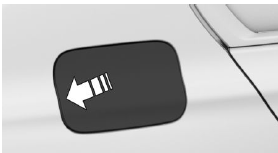
- Turn the fuel cap counterclockwise.

- Place the fuel cap in the bracket attached to the fuel filler flap.
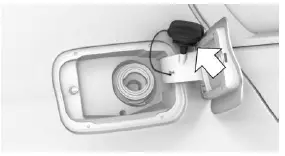
Closing
Warning
The retaining strap of the fuel cap can be jammed and crushed during closing. The cap cannot be correctly closed. Fuel or fuel va-pors can escape. There is a risk of injury or risk of damage to property. Pay attention that the retaining strap is not jammed or crushed when closing the cap.
- Fit the fuel cap and turn it clockwise until you clearly hear a click.
- Press on the fuel filler flap until it engages.
Emergency unlocking
It may be necessary in certain situations to unlock the fuel filler flap manually, for instance with an electrical malfunction.
The release is located in the cargo area.
- Press the button, arrow 1, and open the cover, arrow 2.
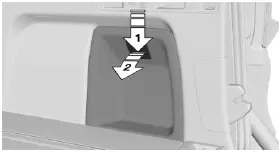
- Pull the green button with the fuel pump icon. This silently releases the fuel filler flap.
- To open the fuel filler flap, press on the rear edge, arrow. The fuel filler flap opens.
- Carefully open the fuel cap. Excess pressure can build up in the fuel tank from gasoline vapor.
- Refuel the vehicle as usual. The residual pressure in the tank may make refueling difficult, for instance, the filler nozzle may shut off frequently. Have the vehicle checked immediately by an authorized service center or another qualified service center or repair shop.
FAQ
A: The BMW X5 Plug-In Hybrid 2023 uses a combination of gasoline and electricity as fuel.
A: Yes, you can charge the X5 Plug-In Hybrid at home using a standard electrical outlet or a Level 2 charging station.
A: The electric-only range of the BMW X5 Plug-In Hybrid 2023 is approximately 30 miles, depending on driving conditions and battery charge.
A: Charging times vary, but using a Level 2 charger, it typically takes around 2-3 hours to fully charge the battery.
A: Yes, the X5 Plug-In Hybrid can be charged at public charging stations equipped with Level 2 or DC fast chargers.
A: Yes, the X5 Plug-In Hybrid is equipped with regenerative braking, which helps recharge the battery while driving.
A: The total driving range depends on factors like driving conditions and battery charge, but it’s typically around 350-400 miles.
A: Yes, you can refuel the gasoline engine at any standard gas station.
A: The X5 Plug-In Hybrid automatically switches between electric and gasoline modes based on driving conditions and the state of charge of the battery.
A: Yes, the vehicle typically comes with a charging cable for standard home charging.
A: Yes, the X5 Plug-In Hybrid can be charged using a DC fast charger for quicker charging times.
A: Yes, many plug-in hybrids, including the X5, have a “hold mode” that allows you to conserve battery charge for use in specific situations.
A: The exact MPG rating for the gasoline engine may vary, but it’s generally competitive with other midsize SUVs.
A: The compatibility of renewable or biofuels may vary by region, so it’s best to check with BMW or your local authorities for specific guidance.
A: Government incentives and tax credits for plug-in hybrid vehicles can vary by location, so it’s advisable to research available incentives in your area to see if you qualify.
Useful Link
View Full PDF: BMW X5 PLUG-IN HYBRID 2023 User Guide
Download Manual: 2023 BMW X5 Specs, Price, Features, Mileage (brochure)
2023 BMW X5 Specs, Price, Features, Mileage (Brochure)

